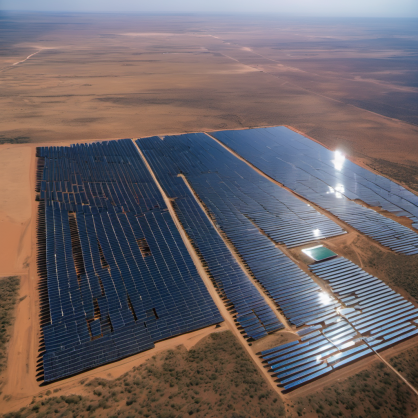Renewable energy capacity in Sub-Saharan Africa is projected to nearly double (https://apo-opa.co/3tbpYZ0) by 2027, with the addition of over 40 GW from alternative power sources. More than 60% of this growth will be derived from South Africa, largely due to its Renewable Independent Power Producer Programme (REIPPP). However, as the world's attention increasingly focuses on optimising energy consumption and minimising CO₂ emissions, the sustainability of the components used in renewable energy projects becomes paramount.
Dr Andrew Dickson, Engineering Executive at CBI-electric: low voltage (https://CBI-LowVoltage.co.za/), emphasises that despite their eco-friendly nature, all electricity generation technologies, including renewables, emit greenhouse gases during their lifecycle. “The carbon footprint (https://apo-opa.co/3tbPi0W) of renewable energy can range from 11 to 740 grams of CO₂ equivalent per kWh. Therefore, to achieve true sustainability, it is imperative to adopt advanced, greener technologies wherever possible.”
He continues by saying, “Something as innocuous as a circuit breaker should be factored in when determining the carbon footprint an installation creates. While these are essential for safeguarding electrical installations, they still consume electrical energy during normal operation and though they are passive devices, they are contributing to CO₂ emissions. Furthermore, this passive energy consumption ultimately translates into monetary costs. Given the growing demand for low-voltage circuit breakers as renewable energy projects expand across South Africa and the continent, it's essential to reduce these emissions and financial costs while also gaining maximum efficiency from the renewable system.”
To this end, Dr Dickson recommends a refocus on Hydraulic-Magnetic (Hy-Mag) circuit breakers over thermal-magnetic counterparts in renewable energy projects. “Hy-Mag circuit breakers utilise magnetic flux to switch, relying on the relationship between current flow and coil turns to create the necessary tripping force. In contrast, thermal-magnetic breakers require the heating of a bimetal strip mechanism, which, by its nature, consumes more electrical energy. This fundamental technology difference results in lower lifetime energy consumption during standard operation of Hy-Mag breakers, reducing total energy losses and carbon emissions.”
He also points out that thermal-magnetic breakers' performance is temperature-dependent, which can be problematic in regions with extreme temperature variations, such as South Africa's Northern Cape which is home to numerous solar power plants. “Hy-Mag breakers, on the other hand, maintain consistent protection regardless of temperature changes, making them more suitable for environments with substantial temperature fluctuations.”
“Furthermore, Hy-Mag breakers' optimal performance within a temperature range of -40 °C to +85 °C minimises nuisance tripping and ensures a more stable solution,” he adds. “This not only enhances operational reliability but also extends the lifespan of the breakers, leading to more dependable performance over time.”
“By adopting greener, more energy-efficient solutions, the industry can reduce carbon emissions, improve energy efficiency, and ensure the long-term success of renewable energy installations. As Sub-Saharan Africa and the world at large transition toward a more sustainable energy landscape, these innovations are pivotal in driving positive change,” concludes Dr Dickson.
Distributed by APO Group on behalf of CBI-electric: low voltage.
About CBI-electric: low voltage:
Established in 1949, CBI-electric: low voltage is a manufacturer and supplier of quality low voltage electrical distribution, protection, and control equipment. Previously known as Circuit Breaker Industries or CBI, the company specialises in the design, development, and manufacturing of circuit breakers, residential current devices, surge protection, wiring accessories, and metering products.
Head quartered in Johannesburg, South Africa, the company is a subsidiary of renowned JSE listed industrial group Reunert (https://www.Reunert.co.za/), with international operations across Africa, Asia, Australia, Europe, and USA.
CBI-electric: low voltage can be found in almost every home and has firmly become a market leader over the last 72 years while supplying products to authorities, utilities, manufacturers, commercial property developers, industrial, mining, telecommunications, and general power distribution applications.
In 2021, the brand launched its smart IoT (internet-of-things) home automation range, called the Astute Range.
For more information about CBI-electric: low voltage visit: www.CBI-LowVoltage.co.za
Latest Stories
-
Lady sues Police and AG over assault in custody
3 mins -
Ghana’s railway sector has been revived under my leadership – Akufo-Addo
23 mins -
Next government must enforce C190 – Women Economic Dialogue Forum
28 mins -
NCCE engages party youth activists at Nandom on peaceful election
30 mins -
SSNIT engages stakeholders on its operations
32 mins -
Defilement: 19-year-old farmer jailed ten years, with hard labour
34 mins -
Bawumia to inaugurate new headquarters of Lands Commission on November 25
35 mins -
Sylvester Tetteh denies demolishing GBC staff bungalow
40 mins -
Signing of peace pact by presidential candidates slated for November 28
48 mins -
Akufo-Addo reiterates commitment to free and fair elections
50 mins -
Climate change impact poses threat to Ghana’s financial stability – BoG Governor
53 mins -
Ursula Owusu-Ekuful assures of leading NPP to victory in Ablekuma West
56 mins -
Akufo-Addo urges armed forces to maintain neutrality, professionalism
1 hour -
Driver jailed 15 years for robbery
1 hour -
Election 2024: Bawumia is a timely asset for NPP and Ghana – Freddie Blay
1 hour

